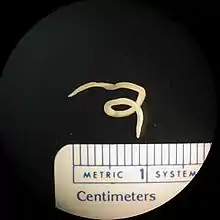| Pseudoterranova | |
|---|---|
 | |
| Scientific classification | |
| Kingdom: | |
| Phylum: | |
| Class: | |
| Order: | |
| Family: | |
| Subfamily: | Anisakinae |
| Genus: | Pseudoterranova |
Pseudoterranova is a genus within the family Anisakidae of parasitic nematodes with an aquatic life cycle. The lifecycle of Pseudoterranova spp. involves marine mammals, pinnipeds (sea lions, seals and walruses) as definitive hosts,[1] planktonic or benthic crustaceans as intermediate hosts and fish which act as second intermediate or paratenic hosts.[2] In some regions, the rise in seal numbers has prefaced a significant increase in fish infected with P. decipiens[3] which is of concern for fish health. Infection with Pseudoterranova may affect the health and swimming ability of the fish host and is therefore of concern for the survival of wild caught and farmed species.[4] Species belonging to this genus have been demonstrated to cause illness of varying exigency in humans if raw or under cooked infected fish is consumed.[5] Cases of human infection have been reported from consuming partially cooked fish infected with Pseudoterranova decipiens,[6] Pseudoterranova cattani[7] and Pseudoterranova azarasi.[8] The propensity of P. decipiens to encyst in the edible portion of fish musculature may make this parasite a considerable threat to human health in undercooked fish.[9]
References
- ↑ Hochberg, N. S.; Hamer, D. H. (2010). "Anisakidosis: perils of the deep". Clinical Infectious Diseases. 51 (7): 806–12. doi:10.1086/656238. PMID 20804423.
- ↑ Brunet, Julie; Pesson, Bernard; Royant, Maude; Lemoine, Jean-Philippe; Pfaff, Alexander W.; Abou-Bacar, Ahmed; Yera, Hélène; Fréalle, Emilie; Dupouy-Camet, Jean; Merino-Espinosa, Gema; Gómez-Mateos, Magdalena; Martin-Sanchez, Joaquina; Candolfi, Ermanno (6 June 2017). "Molecular diagnosis of Pseudoterranova decipiens s.s in human, France". BMC Infectious Diseases. 17 (1). doi:10.1186/s12879-017-2493-7. PMC 5460327. PMID 28583155.
- ↑ Lunneryd, Sven-Gunnar; Boström, Maria Kristina; Aspholm, Paul Eric (1 November 2014). "Sealworm (Pseudoterranova decipiens) infection in grey seals (Halichoerus grypus), cod (Gadus morhua) and shorthorn sculpin (Myoxocephalus scorpius) in the Baltic Sea" (PDF). Parasitology Research. 114 (1): 257–264. doi:10.1007/s00436-014-4187-z. PMID 25367209.
- ↑ Buchmann, Kurt; Mehrdana, Foojan (September 2016). "Effects of anisakid nematodes Anisakis simplex (s.l.), Pseudoterranova decipiens (s.l.) and Contracaecum osculatum (s.l.) on fish and consumer health". Food and Waterborne Parasitology. 4: 13–22. doi:10.1016/j.fawpar.2016.07.003.
- ↑ Shamsi, Shokoofeh; Sheorey, Harsha (May 2018). "Seafood-borne parasitic diseases in Australia: are they rare or underdiagnosed?". Internal Medicine Journal. 48 (5): 591–596. doi:10.1111/imj.13786. PMID 29722196.
- ↑ Shamsi, Shokoofeh (9 February 2019). "Seafood-Borne Parasitic Diseases: A "One-Health" Approach Is Needed". Fishes. 4 (1): 9. doi:10.3390/fishes4010009.
- ↑ Weitzel, Thomas; Sugiyama, Hiromu; Yamasaki, Hiroshi; Ramirez, Cristian; Rosas, Reinaldo; Mercado, Rubén (October 2015). "Human Infections with Nematodes, Chile". Emerging Infectious Diseases. 21 (10): 1874–1875. doi:10.3201/eid2110.141848. PMC 4593429. PMID 26402377.
- ↑ Arizono, Naoki; Miura, Toshiyuki; Yamada, Minoru; Tegoshi, Tatsuya; Onishi, Kotaro (March 2011). "Human Infection with Roundworm". Emerging Infectious Diseases. 17 (3): 555–556. doi:10.3201/eid1703.101350. PMC 3166020. PMID 21392460.
- ↑ Mehrdana, Foojan; Bahlool, Qusay Z.M.; Skov, Jakob; Marana, Moonika H.; Sindberg, Diana; Mundeling, Mai; Overgaard, Bettina C.; Korbut, Rozalia; Strøm, Sverri B.; Kania, Per W.; Buchmann, Kurt (October 2014). "Occurrence of zoonotic nematodes Pseudoterranova decipiens, Contracaecum osculatum and Anisakis simplex in cod (Gadus morhua) from the Baltic Sea". Veterinary Parasitology. 205 (3–4): 581–587. doi:10.1016/j.vetpar.2014.08.027. PMID 25224792.